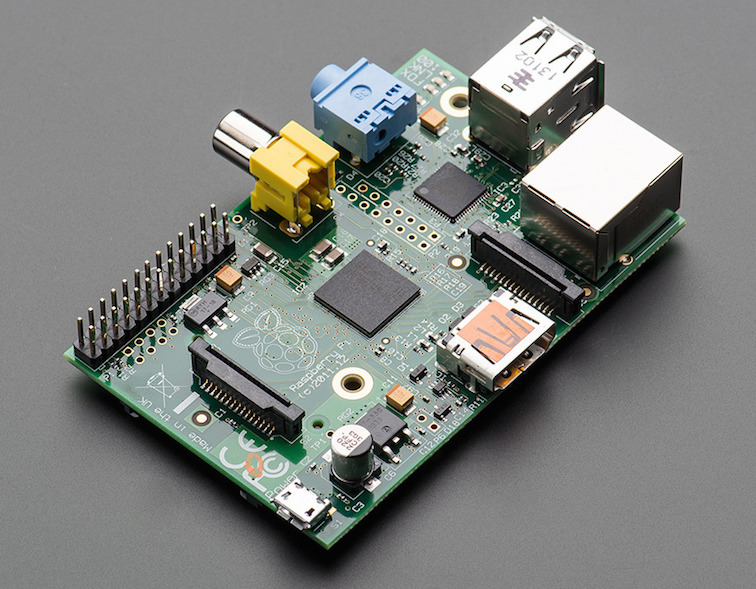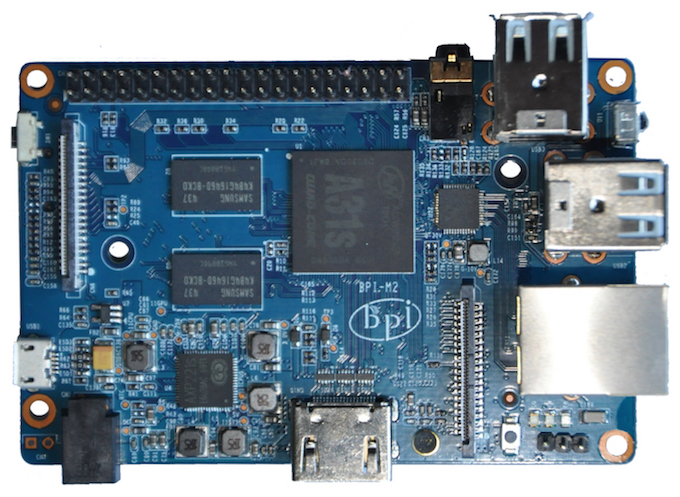Raspberry Pi Alternatives
When it comes to single-board computers, it's probably the Raspberry Pi that comes to mind first. Moreover, the third “raspberry” has recently been released, which is faster and more powerful than previous versions. Tiny computers of this line, originally intended for computer science training, are capable of doing a lot of interesting things. This “machine” can become a solar-powered meteorological station, control center of the “smart home”, a game console for lovers of 8-bit classics, and even the heart of radio-controlled models. It all depends on the imagination, desire and directness of hands.

But despite all its features and benefits, the Raspberry Pi is certainly not perfect. There are other models on the single board computer market. Below is a selection of RPi alternatives that deserve attention.
')

The offer from the South Korean company Hardkernel, which in terms of functionality and price is similar to RPi, is only more powerful. ODROID-C2 also has 4 USB 2.0 ports and a HDMI micro USB OTG port. Cost $ 5 higher than the second and third RPi.
The system works on a 64-bit SoC Amlogic S905 processor with four ARM Cortex-A53 cores which clock frequency is 2 GHz (4x ~ 4600 DMIPS). Supports 2 GB SDRAM third generation. ODROID-C2 is equipped with a graphic accelerator GPU ARM Mali 450 MP3 with a clock frequency of 750 MHz. There is also an IR receiver on the board, an eMMC slot. This mini PC can run on Ubuntu 16.04 and Android 5.1.

Pine A64 Plus is a cheap single-board 64-bit computer. Powered by Allwinner A64 processor with four Cortex-A53 cores and a clock speed of 1.2 GHz. It can be equipped with 1 GB or 2 GB of DDR3 RAM. There are 2x USB 2.0 ports in total.
The stated price is $ 19 for 1 GB of RAM and $ 29 for 2 GB of RAM.

The next in turn is a single board BeagleBone Black worth $ 45. And this is a good alternative for those who lack RPi resources.
The new model has been upgraded with a Sitara AM335X processor based on two ARM Cortex-A8 cores with a clock frequency of 1 GHz. The computer runs the pre-installed Angström Linux, but other operating systems (Ubuntu, Android) can be installed on the SBC. The graphics processor is SGX530. On the motherboard, 512 MB of 800 MHz DDR3 RAM is installed, in addition there is a soldered 2 GB flash memory and two USB 2.0 connectors. Also on board there is a micro HDMI.

The Banana Pi computer is a high level SBC for $ 50. Despite its similarity with RPi, the device is not its clone. At the heart of the system is a dual-core ARM Cortex-A7 processor with a clock frequency of 1 GHz. The RAM is 1 GB DDR3.
Banana Pi is pretty roomy. The computer has 2 USB 2.0 connectors, an Internet output and a SATA 2.0 connector. Available memory: up to a maximum of 64 GB via an SD card and up to 2 TB via the SATA port.

Intel's $ 45 single-board computer that offers support for the Arduino and the ability to load it without external memory. The board works on a 32-bit Quark SoC X1000 processor with a clock frequency of up to 400 MHz. In size, it is somewhat larger than the "raspberry".
Contains 256 MB DDR3, which of course is inferior to RPi models, but its network card size of 100 Mbit, as well as the ability to integrate with the Arduino, make it convenient to work with the electronics industry and robotics.

HummingBoard is similar to RPi. It runs on a 1-GHz dual-core i.MX6 Cortex-A9 processor and contains a GC2000 graphics processor with 1 GB of RAM installed. Android and Linux support is top notch. The basic version also includes: 10/100 Mbps network cards, two USB 2.0 ports, a micro SD card slot, HDMI and SPDIF connectors, as well as UART, GPIO and SPI interfaces.
HummingBoard comes with Android 4.4 KitKat. The price of a computer is $ 75 - $ 100.

Intel released the single-board Minnowboard Max running on an Atom E3845 processor with a frequency of 1.46 GHz and 1 GB DDR2 RAM. Connection methods on the board include 2 USB 2.0 ports, SATA-2 and a gigabit network card.
The cost of a computer is $ 99.

Computer with quad-core ARM Cortex-A9 processor at 1 GHz and 1 GB of RAM. It costs Udoo $ 115 and is a microcomputer capable of running Android as well as various operating systems on Linux.
Udoo Dual is less powerful than RPi or BeagleBone, but its ability to support Android represents a good alternative. With such additional features as a network card, HDMI, Wi-Fi, micro SD and multi USB port - the microcomputer is fully equipped.

The single-board computer based on the OMAP4460 SoC, consists of a dual-core ARM Cortex-A9 processor with a frequency of 1.2 GHz. GPU PowerVR SGX540 with a frequency of 384 MHz. The RAM is 1 GB (DDR2 SDRAM). Also on the board are Wi-Fi, Bluetooth, 10/100 network output and 2 USB 2.0 ports.
A feature of PandaBoard is the ability of the graphics processor to support 1080p format when using the HDMI interface. The sound uses 3.5 mm audio jacks. SD cards are used to store data. Supports SDHC up to 32 GB. The computer works with Android OS (Linaro), Ubuntu (Linaro), RISC OS 5, QNX Neutrino 6.5.0, OpenBSD.
It is a computer PandaBoard ES $ 184.
The market for single-board computers is constantly evolving and growing. Products like Pine A64 Plus and Odroid-C2 offer more features than Raspberry. At the same time, other single-board computers, like Banana Pi and Udoo Dual, although inferior to RPi 3 in terms of power, can be considered as an alternative in their configuration.

But despite all its features and benefits, the Raspberry Pi is certainly not perfect. There are other models on the single board computer market. Below is a selection of RPi alternatives that deserve attention.
')
ODROID-C2

The offer from the South Korean company Hardkernel, which in terms of functionality and price is similar to RPi, is only more powerful. ODROID-C2 also has 4 USB 2.0 ports and a HDMI micro USB OTG port. Cost $ 5 higher than the second and third RPi.
The system works on a 64-bit SoC Amlogic S905 processor with four ARM Cortex-A53 cores which clock frequency is 2 GHz (4x ~ 4600 DMIPS). Supports 2 GB SDRAM third generation. ODROID-C2 is equipped with a graphic accelerator GPU ARM Mali 450 MP3 with a clock frequency of 750 MHz. There is also an IR receiver on the board, an eMMC slot. This mini PC can run on Ubuntu 16.04 and Android 5.1.
Pine a64 plus

Pine A64 Plus is a cheap single-board 64-bit computer. Powered by Allwinner A64 processor with four Cortex-A53 cores and a clock speed of 1.2 GHz. It can be equipped with 1 GB or 2 GB of DDR3 RAM. There are 2x USB 2.0 ports in total.
The stated price is $ 19 for 1 GB of RAM and $ 29 for 2 GB of RAM.
BeagleBone Black

The next in turn is a single board BeagleBone Black worth $ 45. And this is a good alternative for those who lack RPi resources.
The new model has been upgraded with a Sitara AM335X processor based on two ARM Cortex-A8 cores with a clock frequency of 1 GHz. The computer runs the pre-installed Angström Linux, but other operating systems (Ubuntu, Android) can be installed on the SBC. The graphics processor is SGX530. On the motherboard, 512 MB of 800 MHz DDR3 RAM is installed, in addition there is a soldered 2 GB flash memory and two USB 2.0 connectors. Also on board there is a micro HDMI.
Banana pi

The Banana Pi computer is a high level SBC for $ 50. Despite its similarity with RPi, the device is not its clone. At the heart of the system is a dual-core ARM Cortex-A7 processor with a clock frequency of 1 GHz. The RAM is 1 GB DDR3.
Banana Pi is pretty roomy. The computer has 2 USB 2.0 connectors, an Internet output and a SATA 2.0 connector. Available memory: up to a maximum of 64 GB via an SD card and up to 2 TB via the SATA port.
Intel Galileo Gen2

Intel's $ 45 single-board computer that offers support for the Arduino and the ability to load it without external memory. The board works on a 32-bit Quark SoC X1000 processor with a clock frequency of up to 400 MHz. In size, it is somewhat larger than the "raspberry".
Contains 256 MB DDR3, which of course is inferior to RPi models, but its network card size of 100 Mbit, as well as the ability to integrate with the Arduino, make it convenient to work with the electronics industry and robotics.
Hummingboard

HummingBoard is similar to RPi. It runs on a 1-GHz dual-core i.MX6 Cortex-A9 processor and contains a GC2000 graphics processor with 1 GB of RAM installed. Android and Linux support is top notch. The basic version also includes: 10/100 Mbps network cards, two USB 2.0 ports, a micro SD card slot, HDMI and SPDIF connectors, as well as UART, GPIO and SPI interfaces.
HummingBoard comes with Android 4.4 KitKat. The price of a computer is $ 75 - $ 100.
MinnowBoard Max

Intel released the single-board Minnowboard Max running on an Atom E3845 processor with a frequency of 1.46 GHz and 1 GB DDR2 RAM. Connection methods on the board include 2 USB 2.0 ports, SATA-2 and a gigabit network card.
The cost of a computer is $ 99.
Udoo dual

Computer with quad-core ARM Cortex-A9 processor at 1 GHz and 1 GB of RAM. It costs Udoo $ 115 and is a microcomputer capable of running Android as well as various operating systems on Linux.
Udoo Dual is less powerful than RPi or BeagleBone, but its ability to support Android represents a good alternative. With such additional features as a network card, HDMI, Wi-Fi, micro SD and multi USB port - the microcomputer is fully equipped.
PandaBoard ES

The single-board computer based on the OMAP4460 SoC, consists of a dual-core ARM Cortex-A9 processor with a frequency of 1.2 GHz. GPU PowerVR SGX540 with a frequency of 384 MHz. The RAM is 1 GB (DDR2 SDRAM). Also on the board are Wi-Fi, Bluetooth, 10/100 network output and 2 USB 2.0 ports.
A feature of PandaBoard is the ability of the graphics processor to support 1080p format when using the HDMI interface. The sound uses 3.5 mm audio jacks. SD cards are used to store data. Supports SDHC up to 32 GB. The computer works with Android OS (Linaro), Ubuntu (Linaro), RISC OS 5, QNX Neutrino 6.5.0, OpenBSD.
It is a computer PandaBoard ES $ 184.
The market for single-board computers is constantly evolving and growing. Products like Pine A64 Plus and Odroid-C2 offer more features than Raspberry. At the same time, other single-board computers, like Banana Pi and Udoo Dual, although inferior to RPi 3 in terms of power, can be considered as an alternative in their configuration.
Source: https://habr.com/ru/post/391291/
All Articles